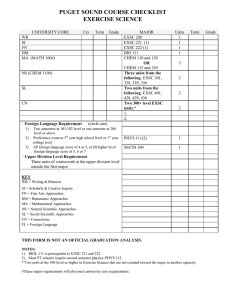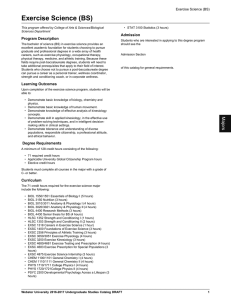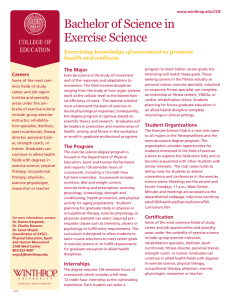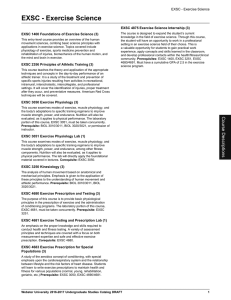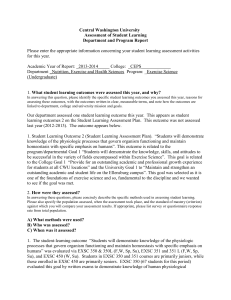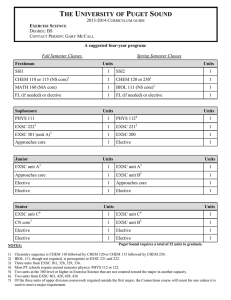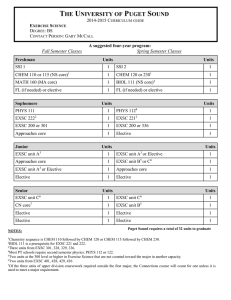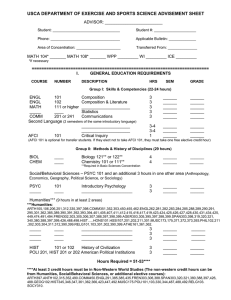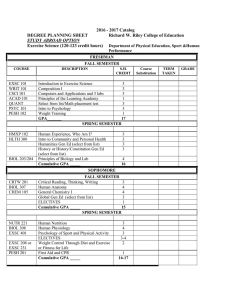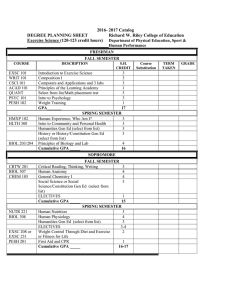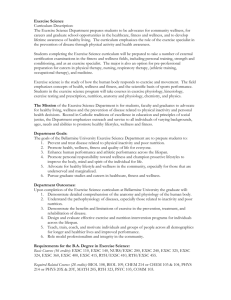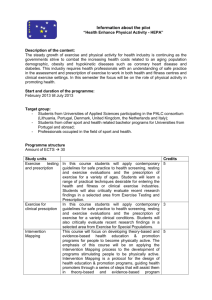2011-2012 Exercise Science Program Assessment
advertisement
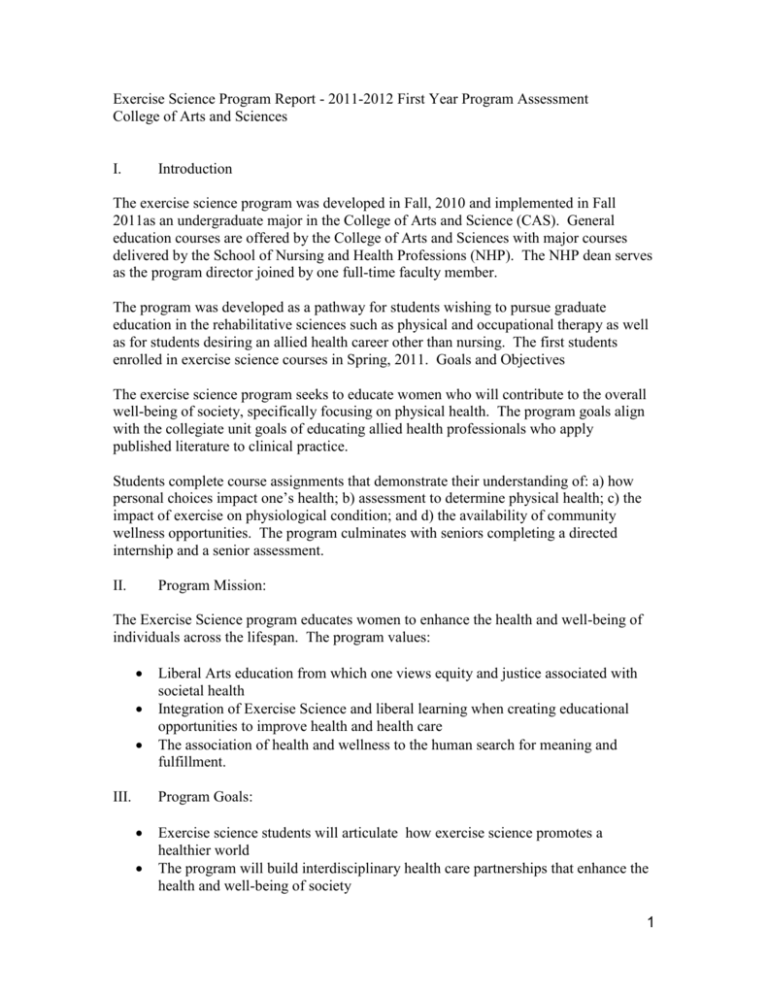
Exercise Science Program Report - 2011-2012 First Year Program Assessment College of Arts and Sciences I. Introduction The exercise science program was developed in Fall, 2010 and implemented in Fall 2011as an undergraduate major in the College of Arts and Science (CAS). General education courses are offered by the College of Arts and Sciences with major courses delivered by the School of Nursing and Health Professions (NHP). The NHP dean serves as the program director joined by one full-time faculty member. The program was developed as a pathway for students wishing to pursue graduate education in the rehabilitative sciences such as physical and occupational therapy as well as for students desiring an allied health career other than nursing. The first students enrolled in exercise science courses in Spring, 2011. Goals and Objectives The exercise science program seeks to educate women who will contribute to the overall well-being of society, specifically focusing on physical health. The program goals align with the collegiate unit goals of educating allied health professionals who apply published literature to clinical practice. Students complete course assignments that demonstrate their understanding of: a) how personal choices impact one’s health; b) assessment to determine physical health; c) the impact of exercise on physiological condition; and d) the availability of community wellness opportunities. The program culminates with seniors completing a directed internship and a senior assessment. II. Program Mission: The Exercise Science program educates women to enhance the health and well-being of individuals across the lifespan. The program values: III. Liberal Arts education from which one views equity and justice associated with societal health Integration of Exercise Science and liberal learning when creating educational opportunities to improve health and health care The association of health and wellness to the human search for meaning and fulfillment. Program Goals: Exercise science students will articulate how exercise science promotes a healthier world The program will build interdisciplinary health care partnerships that enhance the health and well-being of society 1 IV. Program Student Learning Outcomes: V. o Students and graduates will work with health care providers from different disciplines Educate women leaders in exercise science related professions to enhance the well-being of society o 80% of graduates will be employed in a health related field within 1 year post graduation Distinguish similarities and differences of cardiovascular, respiratory, metabolic, and musculoskeletal risk factors in various population groups Design and implement fitness assessments for people across the lifespan Outline appropriate exercise plans, including safety considerations to enhance and/or maintain fitness in apparently health and special populations Develop and apply appropriate teaching strategies designed to maintain or enhance health for individuals and communities Interpret safety plans and emergency procedures and apply the interpretation to exercise testing prescription and training Appropriately integrate current literature into exercise science related activities through written and performance mediums Data Collection Plan for Measuring Objectives – the program will collect data from student course performance on tests, assignments, research papers, presentations, and internship evaluations to determine the effectiveness of the program in meeting program goals and student learning outcomes Second year Program Assessment initiated collection of outcomes data for student learning outcomes and programmatic outcomes. Program Learning Outcomes collected annually Strategic Goal 1: Enrollment Grow the program to 60 students over 5 years Strategic Goal 3: Program Development Enrollment Trends Students and graduates will work with health care providers from different disciplines EXSC 491 Internship and Graduate outcomes Exercise science students will articulate how exercise science promotes a healthier world Strategic Goals 8: Service to Students and Community Senior Assessment Narrative 80% of graduates will be employed in a health related field within 1 year post graduation Graduate outcomes based on exit interviews and graduate surveys 2 Student Learning Outcomes to be assessed on a 3-year cycle Year 1 Students design and implement fitness assessments EXSC 301 Strength Training EXSC 340 Exercise Prescription and Testing for General Populations Students outline appropriate exercise plans Year 2 EXSC 301 Strength Training EXSC 340 Exercise Prescription and Testing for General Populations EXSC 350 Exercise Prescription and Testing for Special Populations Students will interpret safety considerations and emergency procedures associated with exercise prescription and testing EXSC 301 Strength Training EXSC 321 Health and Wellness Programming EXSC 340 Exercise Prescription and Testing of General Populations Students develop and apply appropriate teaching strategies Year 3 EXSC 200 Personal Fitness EXSC 321 health and Wellness Programming Students demonstrate appropriate integration of current literature into exercise science related activities EXSC 310 Kinesiology EXSC 430 Research and Evidence-based practice and the Exercise Science Senior Assessment Distinguish similarities and differences of cardiovascular, respiratory, metabolic, and musculoskeletal risk factors in various population groups Exercise Science Senior Assessment EXSC 340 Exercise Prescription and Testing for General Populations EXSC 350 Exercise Prescription and Testing for Special Populations Repeat assessment cycle noted above 3 Appendix A: Mission, Vision, and Student Learning Outcomes Mission The Exercise Science program educates women to enhance the health and well-being of individuals across the lifespan. The program values: Liberal Arts education from which one views equity and justice associated with societal health Integration of Exercise Science and liberal learning when creating educational opportunities to improve health and health care The association of health and wellness to the human search for meaning and fulfillment. Vision The Exercise Science program values education centered on: Women seeing the importance of exercise science in promoting a healthier world Values of equity and justice associated with quality of life, particularly as it relates to the health and well-being of society Academic integrity and rigor required to comprehend, integrate, and apply exercise science theory and practice for promoting the health and wellness of people across the lifespan Building interdisciplinary health care partnerships that create community service options and enhance the health and well-being of society Women’s leadership in exercise science related professions, communities, and the world thereby improving quality of health across the lifespan. Student Learning Outcomes Upon completion of the Exercise Science program a student will: 1. Distinguish similarities and differences of cardiovascular, respiratory, metabolic, and musculoskeletal risk factors in various population groups 2. Design and implement fitness assessments for people across the lifespan 3. Outline appropriate exercise plans, including safety considerations, to enhance and/or maintain fitness in apparently healthy and special populations. 4. Develop and apply appropriate teaching strategies designed to maintain or enhance health for individuals and communities. 5. Interpret safety plans and emergency procedures and apply the interpretation to exercise testing, prescription, and training. 4 6. Appropriately integrate current literature into exercise science related activities through written and performance mediums. 5
